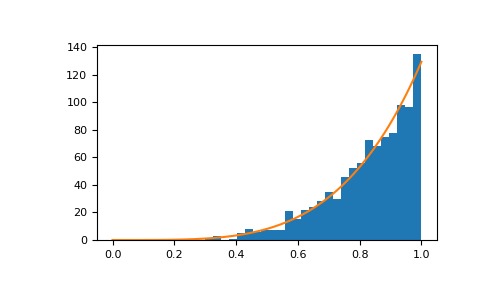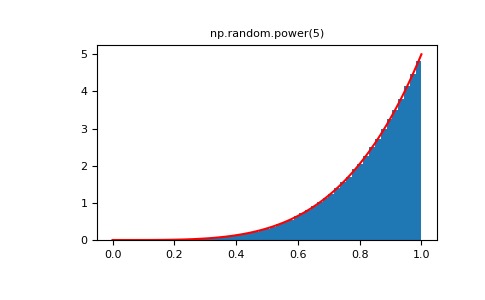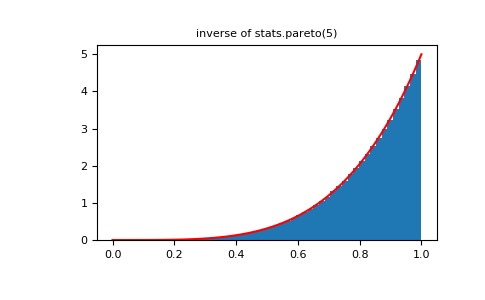用法:
RandomState.power(a, size=None)从具有正 index a-1的功率分布中以[0,1]抽取样本。
也称为幂函数分布。
参数: - a: : float 或 array_like of floats
分布参数。必须为非负数。
- size: : int 或 tuple of ints, 可选参数
输出形状。如果给定的形状是
(m, n, k), 然后m * n * k抽取样品。如果尺寸是None(默认),如果返回一个值a是标量。除此以外,np.array(a).size抽取样品。
返回值: - out: : ndarray或标量
从参数化功率分布中抽取样本。
异常: - ValueError:
如果<1。
注意:
概率密度函数为
幂函数分布只是帕累托分布的倒数。它也可能被视为Beta分布的特例。
例如,它用于建模保险索赔的over-reporting。
参考文献:
[1] 克里斯蒂安·克莱伯(Christian Kleiber),塞缪尔·科茨(Samuel Kotz),“经济学和精算科学中的统计规模分布”,威利,2003年。 [2] Heckert,N. A.和Filliben,James J.“ NIST手册148:数据图参考手册,第2卷:让子命令和库函数”,美国国家标准技术研究所手册 Series ,2003年6月。https://www.itl.nist.gov/div898/software/dataplot/refman2/auxillar/powpdf.pdf 例子:
从分布中抽取样本:
>>> a = 5. # shape >>> samples = 1000 >>> s = np.random.power(a, samples)显示样本的直方图以及概率密度函数:
>>> import matplotlib.pyplot as plt >>> count, bins, ignored = plt.hist(s, bins=30) >>> x = np.linspace(0, 1, 100) >>> y = a*x**(a-1.) >>> normed_y = samples*np.diff(bins)[0]*y >>> plt.plot(x, normed_y) >>> plt.show()
将幂函数分布与Pareto的倒数进行比较。
>>> from scipy import stats # doctest:+SKIP >>> rvs = np.random.power(5, 1000000) >>> rvsp = np.random.pareto(5, 1000000) >>> xx = np.linspace(0,1,100) >>> powpdf = stats.powerlaw.pdf(xx,5) # doctest:+SKIP>>> plt.figure() >>> plt.hist(rvs, bins=50, density=True) >>> plt.plot(xx,powpdf,'r-') # doctest:+SKIP >>> plt.title('np.random.power(5)')>>> plt.figure() >>> plt.hist(1./(1.+rvsp), bins=50, density=True) >>> plt.plot(xx,powpdf,'r-') # doctest:+SKIP >>> plt.title('inverse of 1 + np.random.pareto(5)')>>> plt.figure() >>> plt.hist(1./(1.+rvsp), bins=50, density=True) >>> plt.plot(xx,powpdf,'r-') # doctest:+SKIP >>> plt.title('inverse of stats.pareto(5)')


注:本文由纯净天空筛选整理自 numpy.random.mtrand.RandomState.power。非经特殊声明,原始代码版权归原作者所有,本译文未经允许或授权,请勿转载或复制。
